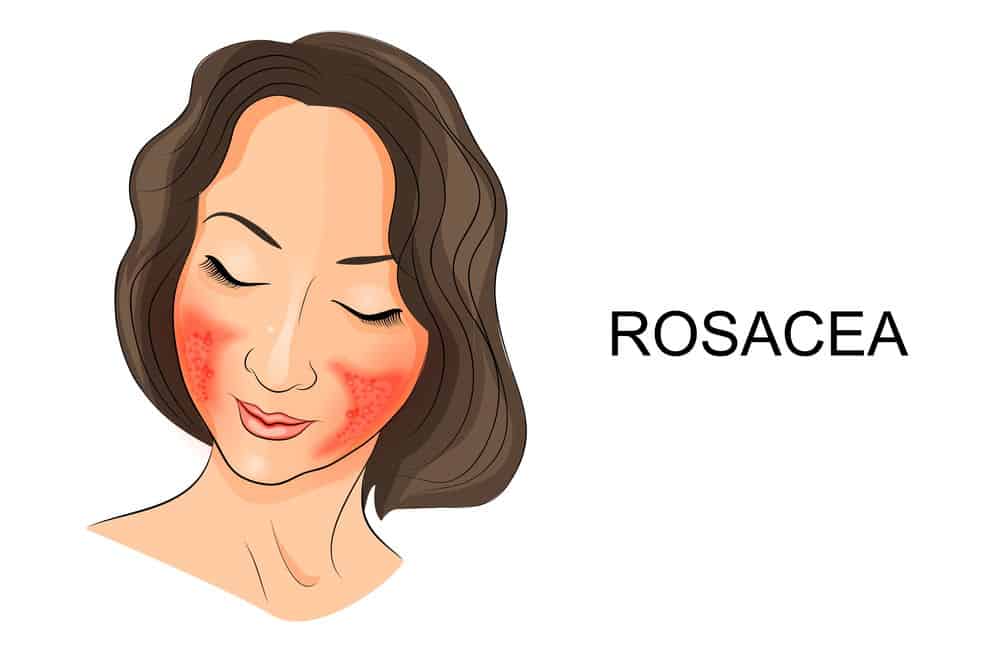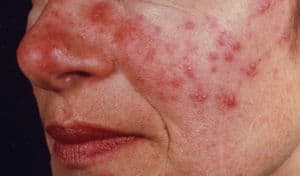
It often starts out insidiously as a cute tendency to blush, especially on hotter days. The next thing you know, it has spread from your nose and cheeks down to your chest and maybe even your back. Tiny red lines appear on your skin and—horror of horrors!—a breakout worthy of a teenager has cropped up in the most unsightly manner possible!
What you may be experiencing is a skin condition called rosacea and it is quite common. It is so common, in fact, that you may be surprised to find that even famous people like Princess Diana had rosacea. However, the redness, the stinging, and the breakouts can be quite a burden, especially when the symptoms flare up.
So, what is the real deal on rosacea? And how do you get rid of it?
What is Rosacea?
 First things first—you might be wondering what rosacea truly is.
First things first—you might be wondering what rosacea truly is.
Well, it is a common, chronic skin condition that usually starts out with blushing or flushing more easily than other people. It is so common that even famous people like former US president Bill Clinton and Princess Diana had rosacea, too.
The redness usually spreads over time from the cheeks to the other areas, like the forehead and the chin and even down to the back and chest. Small blood vessels may become prominent, resembling thin red lines on the face called telangiectasia. Sometimes, little, red bumps filled with pus can also develop in these areas and be mistaken for acne.
It usually develops at ages 30 to 50 years old and very rarely in younger age groups. Fair-skinned women are more likely to get rosacea than their male counterparts but compared to men, females rarely have the severe forms of rosacea.
What Causes Rosacea?
Unfortunately, nobody knows at this point what really causes rosacea to develop. Researchers are still trying to come up with a definite answer as to what causes rosacea but so far, they have speculated the following things about this condition:
- It might run in the blood. It has been noted that people with rosacea often have other relatives who have rosacea themselves, which led scientists to theorize that genes may have something to do with rosacea. However, nothing definite has been proven yet.
- It might be an immune condition. Most chronic conditions like allergies are based on the reactions of the immune system and rosacea might not be so different. Studies have shown that people with acne-like rosacea have the tendency to a certain kind of bacteria called Bacillus oleronius. The overreaction of the immune system might also cause the more visible signs of rosacea but this is still being studied.
- Another kind of bacteria may possibly be involved. Another bacterium, Helicobacter pylori, has been linked to rosacea although a causative link between this bug and rosacea is yet to be established. Helicobacter pylori are usually found in the stomach and can cause ulcers to form.
- Certain mites have been implicated as causative agents of rosacea, too. Most notable among them is the mite called Demodex folliculorum, which are normally happily living in the skin of healthy people. However, people with rosacea seem to have an abundance of these little guys so there might be a link between them.
- Activation of certain skin peptides. Certain conditions that are also noted triggers of rosacea flares like exposure to sunlight, spicy foods, exercise, and stress have been noted to activate substances on the skin called peptides. These peptides, in turn, activate the immune system and blood vessels, causing the more visible signs of rosacea to emerge.
However, none of these theories are set in stone and scientists are still trying to pinpoint what exactly causes rosacea but these things are nice to keep in touch, especially when you are trying to avoid flare ups.
What are The Signs and Symptoms of Rosacea?
Most often, people with rosacea start with the observation that they tend to blush or flush easily compared to other people. Over time, the redness can spread to other areas and they sometimes develop little bumps that might be confused with acne.
Doctors have described four subtypes of rosacea to classify the different kinds that crop up in people.
1. Erythematotelangiectatic Rosacea
This is the first subtype of rosacea and quite possibly, the mildest form. In this subtype, a distinctive redness is usually noted on the nose and cheeks. Swollen blood vessels may manifest as thin red lines on the skin called telangiectasias.
The skin may be very sensitive in this form of rosacea and patients often report a burning or stinging sensation.
2. Papulopustular Rosacea

This is the subtype of rosacea that can be mistaken for acne. This also occurs mostly in people with oily skin and acne-like breakouts tend to occur on the reddened areas, especially when triggered by certain conditions.
As with the first subtype, the skin may sting or burn and blood vessels may become visible. Plaques or raised patches of skin may also be noted in this subtype.
3. Phymatous Rosacea

You might remember an old star in the 1920’s by the name of W.C. Fields, who developed a bulbous nose. Yep, that was rosacea, too.
The third subtype of rosacea is thankfully rare. This subtype tends to develop thick, bumpy skin called phyma. When the skin on the nose thickens and becomes redder as in the case of Mr. Fields, the condition is called rhinophyma.
This subtype of rosacea also tends to have oily skin as in papulopustular rosacea.
4. Ocular Rosacea
Rosacea can also affect the eyes and is termed ocular rosacea. In this subtype, the eyelids are noted to be red and swollen with visible telangiectasia. Eyes have a watery and/or bloodshot appearance.
Patients with ocular rosacea also have eye complaints such as itchiness or dryness, as wells as a feeling of grittiness as if there is always sand in the eyes. Eyes can also burn and sting and can be quite sensitive to light. Blurry vision is also common in this subtype.
How do I know I have Rosacea?
If you are blushing more than usual, then it may be time to see a dermatologist, a doctor specializing in skin problems.
There are no tests that will confirm rosacea. The diagnosis is based mainly on the signs and symptoms as well as your history, so expect to have the doctor ask you certain questions on your appointment. These questions may also help you discover what your triggers for rosacea flares are.
Laboratory tests might be done just to rule out other skin conditions like acne or psoriasis but rosacea can be diagnosed merely by your honest history and a thorough physical examination.
If your eyes are also affected, you might also be referred to an eye doctor or ophthalmologist.
How do I Get Rid of Rosacea?
Now that we know what rosacea is and what it looks like, how do we get rid of it? Can we actually cure ourselves of this embarrassing condition?
There is No Cure
Just as nobody knows the real cause of rosacea, there is also, quite unfortunately, no definite cure that will get rid of it permanently. As it is a chronic condition, it can last for years and eventually go away on its own in about nine to thirteen years.
Avoidance of Triggers
The management of rosacea largely depends on managing flare ups and avoiding triggers to avoid such. Most common triggers to avoid include:
- Alcohol
- Spicy foods
- Extremes in temperature
- Exposure to sunlight
- Stress
- Exercise Medications.
Medicines
Used for rosacea are mostly for the alleviation of the signs and symptoms, depending on the subtype of rosacea you have. Some of these may include:
- An emollient for dry skin
- Antibiotics (both topical and oral) to help control bacteria in the pustular lesions
- Sunscreens to prevent flare ups caused by exposure to sunlight
Lasers or Light Therapy

Light therapy or lasers can be used by dermatologists to remove the thickened skin on certain areas affected by rosacea, especially on the nose. Lasers are best used on those tiny, prominent blood vessels called telangiectasia, which is common in people with rosacea. Studies show that the use of lasers will visibly minimize the appearance of redness and the telangiectasia on the nose and cheeks.
Conclusion
Rosacea is a chronic skin condition that is most unfortunately incurable at the present moment. The best you can do is to consult your doctor if you feel you have rosacea and avoid triggers that can cause flare ups or aggravate your condition. You can also use some medications to help with the dryness as well as sunscreens to protect your skin from exposure to sunlight. Lasers can also help with removing the thickened skin and reducing the appearance of flushing and telangiectasia.
Did you find this article informative and enjoyable? Do you know anybody with rosacea? What are your other suggestions on how to get rid of rosacea and its flare ups? Let us know in the comments below and don’t forget to share the information with your family and friends!

Hi Everyone, BeYoungAholic’s aim is to help women who have lost their self-confidence because of the way they look. We will provide you tips and bits of advice on how to take care of yourself and maintain your youthful look. So, Enjoy the blog!
